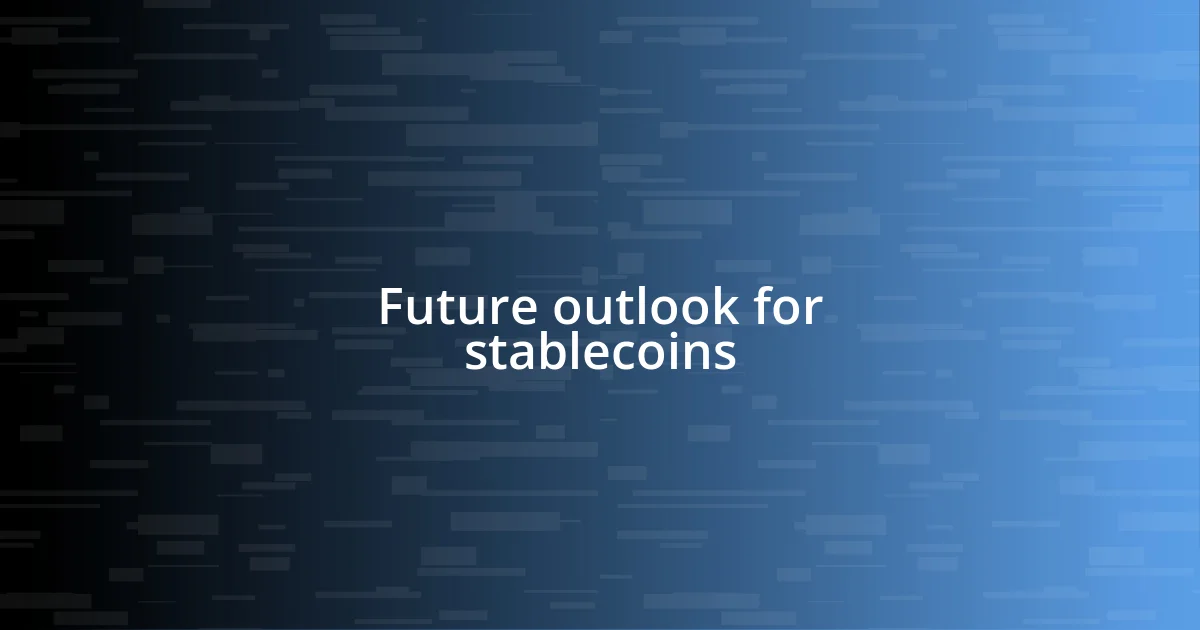Key takeaways:
- Your initial skepticism about stablecoins transformed into appreciation after understanding their role in crypto market stability and everyday transactions.
- Learning about various types of stablecoins and effective investment strategies like dollar-cost averaging solidified your confidence in navigating the market.
- Insights gained from evaluating risks, such as liquidity and regulatory challenges, emphasized the importance of diversification and emotional resilience in stablecoin investments.

My introduction to stablecoins
My first encounter with stablecoins was quite eye-opening. I remember sitting at my desk, scrolling through cryptocurrency news when I stumbled upon the concept. “Why would anyone create a coin tethered to something as mundane as the dollar?” I thought at the time. Little did I know, this question would lead to a whole new understanding of the digital currency landscape.
It was during a coffee break at a blockchain meetup that I really began to appreciate the value of stablecoins. A fellow attendee passionately explained how they offer a safer haven amidst the often tumultuous tides of the crypto market. Listening to her share how stablecoins helped her navigate market volatility opened my eyes—suddenly, it made sense to me.
As I delved deeper, I couldn’t help but feel a mix of excitement and curiosity. How could a stablecoin, designed to maintain its value, change the way people perceive digital currency? This blend of stability and innovation struck a chord within me, prompting me to explore how these tokens could facilitate everyday transactions and provide a bridge between traditional finance and the evolving world of cryptocurrencies.

Understanding stablecoin basics
Stablecoins are fascinating because they offer a unique blend of stability and liquidity. I still vividly recall the moment I first grasped the concept of pegging a digital asset to traditional currencies. It felt revolutionary—like finding a way to anchor a ship amid a stormy sea. By linking a cryptocurrency’s value to stable assets like the US dollar or gold, these coins provide a cushion against the wild fluctuations that characterize the crypto market.
What truly captivated me was learning about the different types of stablecoins during a webinar I attended. I was surprised to discover there are three main categories: fiat-collateralized, crypto-collateralized, and algorithmic stablecoins. Each type has its mechanisms for maintaining stability, and understanding these distinctions helped me appreciate the nuances of the market. It was almost like examining the inner workings of a clock—every cog and gear has its role in keeping the time.
As I navigated through various stablecoin projects, I began to realize their potential to revolutionize digital transactions. I remember testing an app that enabled me to send stablecoins directly to a friend for a cafe visit. It felt incredibly seamless—no need to convert currencies or worry about the value plummeting. That moment illustrated to me just how essential stablecoins could become in everyday life, bridging the gap between digital assets and conventional currencies.
| Type of Stablecoin | Description |
|---|---|
| Fiat-Collateralized | Backed by reserves of fiat currency, typically maintained 1:1 with a stable asset. |
| Crypto-Collateralized | Secured by reserves of other cryptocurrencies, often over-collateralized to manage volatility. |
| Algorithmic | Regulates supply and demand through algorithms to maintain value without direct backing. |

Exploring my investment strategies
Exploring investment strategies in stablecoins has been a thrilling journey. One of the first strategies I embraced involved dollar-cost averaging. This tactic allowed me to spread my investments over time, minimizing the impact of market volatility. I would set a fixed amount to invest weekly, regardless of the market price, which took much of the guesswork out of investing. I recall one particular week when prices dipped; instead of panicking, I felt empowered to buy more, which ultimately benefited my portfolio.
Here’s a breakdown of my core strategies:
- Dollar-Cost Averaging: Investing a fixed amount regularly to avoid timing the market.
- Diversification across types: Balancing between fiat-collateralized and algorithmic stablecoins to hedge risks.
- Utilizing Yield Farming: Earning interest on my stablecoin holdings through lending platforms.
- Staying Informed: Regularly researching market trends and stablecoin developments to adapt my strategy.
Tinkering with these methods, I faced moments of doubt, particularly during significant market fluctuations. I remember staring at the numbers during a downturn, questioning my approach. However, I learned to trust the principles I had set. I truly found comfort in knowing that I wasn’t merely reacting to the market but rather following a well-considered plan that allowed me to embrace opportunities without fear. Each step reinforced my belief in the stability that these coins promised.

Evaluating risks in stablecoins
When it comes to evaluating risks in stablecoins, I’ve encountered a variety of challenges that made me rethink my approach. One of the stark realizations I had was regarding the reliance on the entity backing the stablecoin. For instance, I remember when a major project faced scrutiny over its reserve transparency. This incident initiated a deep dive into understanding how vital it is to evaluate not just the currency’s stability but also its backing’s credibility. Would I trust a stablecoin that didn’t provide regular audits? That question still lingers in my mind today.
Another aspect that often catches new investors off guard is the liquidity risk associated with certain stablecoins. I learned this firsthand when I attempted to convert a lesser-known algorithmic stablecoin back into fiat. It wasn’t about the value—it was the sheer difficulty of finding someone willing to trade. Feeling stuck in that moment taught me more about market dynamics than any article ever could. If liquidity is low, how can I be assured I can cash out when needed? It’s a lesson that prompted me to favor widely adopted stablecoins when diversifying my portfolio.
Lastly, I can’t overlook the regulatory uncertainty looming over stablecoins. I remember reading about new legislation proposals and feeling a mix of excitement and anxiety. These frameworks could redefine the entire landscape, potentially impacting the value and usability of every stablecoin out there. How would I adjust my strategy if my trusted stablecoins suddenly faced heavy regulations? This thought keeps me on my toes, highlighting the ever-changing nature of the market and the importance of staying well-informed.

Analyzing market trends and performance
Analyzing market trends and performance in the stablecoin sector has been one of the most enlightening aspects of my journey. I recall the exhilaration of watching seasonal trends influence demand and, consequently, prices. For instance, during periods of economic uncertainty, like major geopolitical events, stablecoins often acted as safe havens. It made me wonder: how could I leverage these patterns to my advantage? By closely monitoring these shifts, I learned to adjust my allocations, ensuring that I remained at the forefront of emerging opportunities.
Another notable trend is the growing adoption of stablecoins among institutional investors. I distinctly remember joining an online forum where seasoned traders discussed how institutions were increasingly integrating stablecoins into their portfolios. This revelation opened my eyes to the potential for greater liquidity and stability in the market. I felt a rush of optimism, as I realized that if bigger players were engaging with stablecoins, then perhaps I was investing in something fundamentally sound and on the brink of widespread acceptance.
Importantly, I’ve also observed how technological advancements influence stablecoin performance. The rise of DeFi—decentralized finance—platforms has reshaped the landscape. I experienced this firsthand when I utilized a yield farming platform. The excitement of seeing my stablecoins earn interest was a validation of my research. It made me reflect on how swiftly innovation can alter market dynamics. What would the future hold for stablecoins as they adapt to these changes? Staying ahead in this fast-evolving environment is essential, and I continue to track these trends actively to ensure my strategies remain relevant.

Lessons learned from my experience
One of the most significant lessons I’ve learned is the importance of diversification within the stablecoin market. Early on, I remember putting all my trust in a single stablecoin, thinking it would shield me from volatility. When a brief market correction hit, I felt a wave of panic as I watched my investment fluctuate. That taught me to spread my investments across different stablecoins, balancing risks and ensuring that I’m not overly dependent on one asset.
I also discovered that understanding the underlying technology of stablecoins is crucial. I’ll never forget when I participated in a community discussion about an upcoming stablecoin launch. The excitement in the air was palpable until someone brought up potential technical flaws. Suddenly, my enthusiastic projections felt naive. This experience made me realize that without a grasp of the technology behind these coins, I could easily fall victim to misinformation or hype. It reinforced the idea that staying educated is not just beneficial; it’s essential in this fast-paced market.
Lastly, my journey highlighted the importance of emotional resilience. In my early days, I often reacted impulsively to price swings, which led to unnecessary stress and, at times, regrettable decisions. I vividly remember one evening when I nearly sold all my holdings after a sudden dip. Catching myself just in time, I reflected on how crucial it is to have a solid strategy and stick to it, regardless of market noise. This self-awareness has become invaluable, reminding me that staying calm and collected often leads to more rational and beneficial choices.

Future outlook for stablecoins
The future of stablecoins is promising and intriguing. As I look ahead, I can’t help but feel a sense of excitement about the potential for increased regulatory clarity. Many discussions in the community suggest that clearer regulations could inspire confidence among both institutional and retail investors. Have you ever considered how regulation might transform the landscape? I’ve found that a stable regulatory framework could make the market more resilient and attract even more participants.
Another aspect worth discussing is the integration of stablecoins into everyday transactions. I remember when I first paid for a service with a stablecoin; it felt like a leap into the future. More businesses are beginning to adopt this payment method, showcasing a shift in consumer behavior. As adoption grows, could we be paving the way for stablecoins to become as common as traditional currencies? Personally, I wouldn’t be surprised if this trend accelerates, making digital payments more streamlined and accessible for everyone.
Lastly, there’s the impact of innovations like CBDCs (central bank digital currencies) on the stablecoin market. The idea of central banks creating their own digital currencies prompts a fascinating question: will this coexist with existing stablecoins or create competition? From my perspective, while CBDCs could reshape how we view digital money, they might also validate the use of stablecoins as a bridge within the broader crypto economy. The balance is delicate, yet I believe that stablecoins will find their niche, supporting a diverse financial ecosystem that benefits all users.














